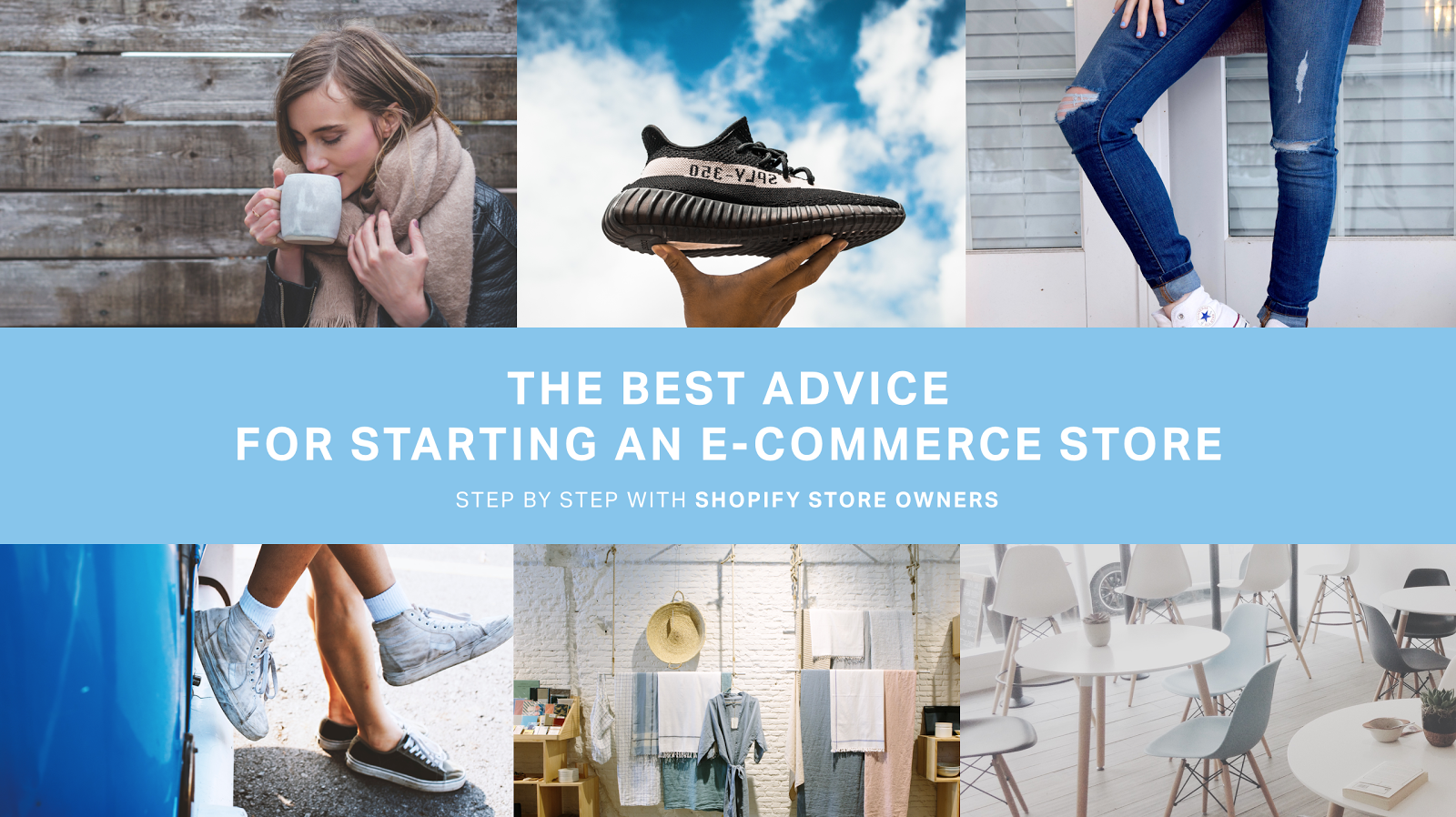Having interviewed dozens of successful eCommerce entrepreneurs, I know there are many steps and challenges involved in starting an eCommerce business. Without proper direction, it is easy to lose focus on what is important. Especially in the early days, having to learn new technical skills and business responsibilities can leave you with an overwhelming sense of analysis paralysis.
My advice to new founders is to find a guide that will help you start and grow your business. This guide should provide a clear timeline of everything required at each step of the process and use real examples from eCommerce stores to help you feel confident, not overwhelmed.
Frustrated in not being able to find such a guide, I decided to create one myself.
Here is a clear, actionable, step-by-step guide on starting an eCommerce store and growing it into a successful business. At every step, I will provide useful resources and real examples from successful business owners.
We will cover each of the below topics in detail:
- Finding the right product
- Validating
- Getting your first products
- Creating your online store
- Launching
- Next steps
No matter what stage you are at, this guide should be your blueprint for starting and growing your own eCommerce business.
Step 1. Finding the Right Product
Choosing what you are going to sell when starting an eCommerce business is no different than starting any other business. You have to
- find a gap in the market that you believe you can fill, or
- create something better than what currently exists.
But there are some differences. For example, selling online drastically increases the potential size of your market when compared to a traditional retail store. This means certain niches that would not sustain a business when selling in a brick and mortar store might be sustainable when you can sell to customers anywhere in the world.
With digital products and services, there are also hundreds of new categories to consider, such as digital downloads and individually customized products.
Sources of Inspiration
Here are some of the most common places successful eCommerce store owners found their product ideas from:
Problems you face every day – Keep Em Quiet created a product purely to solve the problem of how to keep their children entertained during long trips. They realized it was a problem other parents might face as well and created a business around the idea.
Source: KeepemQuiet
Online communities – What are some up-and-coming trends you see arising in the blogs or communities you follow? How can you capitalize on them? Communities like Reddit, Product Hunt, Kickstarter and even Instagram are a hive of early adopters. If you can tap into these communities to find your product, they might double as a good avenue for finding your first sales.
Existing marketplaces – What products are currently becoming popular on sites like Amazon, eBay & Etsy? Is there an unmet need for a variation of these products?
Personal knowledge – Is there an industry or product category you are particularly knowledgeable in? Would people pay you for this knowledge? Fashion is a good example of people respecting the content that influencers provide. You can use this influence to create a store that showcases products you believe in.
While these all seem like very different sources of inspiration, there are 3 things most successful eCommerce stores do well that you should keep in mind:
1. Be passionate about your products
This is especially crucial in the early days when you have to keep grinding away while sales are still low. As an entrepreneur, you know you can be working 80-hour weeks to avoid the 40-hour week, so you want to make sure you’re spending your time in an industry that you are passionate about.
It might not be just the product itself that you are passionate about, but potentially the opportunities it might provide. Perhaps it gives you the chance to disrupt an existing market or travel in search of new products. Scott from The Reluctant Trading Experiment wasn’t particularly excited about pepper; in fact, he was reluctant about the whole idea. But… he was excited about the quality of the new product he had found, the story behind it, and the opportunities it presented him to travel.
Source: The Reluctant Trading Experiment
2. Utilize an existing audience or contacts
Many founders look to their own lives to see what human resources they have that they can leverage to start their business. This might mean targeting where you are already a valued member of a community – making it easier to get your first sales and reach out for feedback. Or maybe, you have connections to someone who can supply you with a unique product.
The founder of Tiny Hands started by posting her first product to a blog she was an active member of. As more and more people wanted it, she expanded onto Etsy and, eventually, her own website.
3. Start simple and expand
When you’re starting out, you can’t spread yourself too thin across too many product categories. If you’re launching a new store, focus on the one product or product category that your customers will come back to you for. Then, look to expand your range and cross into similar categories. TITAN Survival spent a year developing a high-quality paracord product and used the success of this first product to expand into other survival products.
You don’t have to have all three of these ideal characteristics checked. In fact, it is probably better to feel really strongly about one or two than it is to be kind of average about all three.
Whatever your entrepreneurial personality, be open to revising your original idea based on the feedback you get from your potential customers. This is where the next step comes in: validation.
Step 2. Validating Your Idea
You’ve found a product that gets you excited, but it won’t work as a business if it doesn’t get other people excited too. So how do you test whether it will work?
One common factor among many successful founders is that they find a way to test how receptive people are to their idea without launching their full online store. This approach is the basis of the Lean Startup methodology. The Lean Startup outlines how you can create a successful business by building the smallest version, measuring its success and learning from the results to improve in an ever-repeating cycle. So once you have an idea, the next step is to test it. From testing, you will either have the validation that people want your product, or you will gain insight into what people would actually like.
Here are three questions you should try to answer when validating your idea:
- How much competition is in this space and am I able to stand out?
- How many people do I think will buy this product, and what do those people look like?
- How much profit will I make after factoring in costs like shipping, manufacturing and returns?
And here are some of the ways you can test your product to find the answers:
Start offline
Rather than investing the time and money into their online store straight away, Tote Tails started their business by going to local markets with a handmade version of their product.
This approach is fantastic for a couple of reasons. It has very low startup costs (you can accept credit cards using Square or the basic Shopify plan and begin selling straight away). You can also talk directly to customers to get their feedback on your product before you go into full-scale production.
Look at local markets and communities for ways you can begin selling your products to an audience straight away. The lessons and feedback you learn will be more valuable than your initial sales.
Gauge interest with tools from Google
Maybe you’ve discovered an upcoming niche that you think will be really popular. However, it might be that you’re actually on the tail end of this trend and people have already begun to lose interest.
Google Trends shows you what people are searching for over time. You can also use the keyword tool to see how many people are searching for that term and compare it to similar terms. This is a good way to gauge how many people might be interested in your product.
Set up the smallest version of your website
Sometimes the only way to really test your product is to actually set up a site. But don’t expect to create the final version of your store; it’s just for validation of your idea. By the time you invest all of your resources into getting a perfect website done, it likely will be out of date. You aren’t going to know what your store should really look like until you get honest customer feedback about both your product and your site.
Thankfully, it is super easy to set up a landing page or a basic store. Having this setup will give you a single point of entry to refer customers to. You can also use Facebook & Google Ads to drive your initial traffic to see if it actually is a product people are interested in buying. You can then use that data to develop your final site.
Resources
- The Lean Startup
- Google Trends & Google Keywords
- Square – Payment Processing
- Leadpages – Landing pages
Step 3. Getting Your First Products
Once you have decided what you are going to sell and validated that there is demand, you need to figure out how exactly you are going to create it or where you are going to find your supplier. Here you have a few options:
Create Your Product Manually
For businesses with a unique product, like a fashion or jewelry store, often you can test your store with a limited offering. Find ways to create your product manually at first and then increase automation as your business grows.
To keep their costs low, Thrifty Pup used left-over material samples to create their first product. This also gave them a unique product offering that their customers loved and allowed them to release new iterations very quickly.
Source: Thrify Pup
Import your Products
If you are looking to import products from China, Alibaba is an easy way to source products in bulk. AliExpress and Alibaba allow you to browse products from thousands of wholesalers and retailers directly. You can often negotiate with suppliers to get a limited run or sample of products before placing a larger order. Connecting with vendors via Alibaba can also be a good entry point to sourcing manufacturers or cheaper wholesale providers.
Manufacture your Products
Finding the right manufacturing partner is very important. TITAN Survival spent a year looking for the right manufacturer for their product, but once they found them, they could work with them to release a new line based on the success of their first product.
Sometimes you just can’t test your products without creating them first. But you can set up a landing page or even a Kickstarter campaign to gauge interest in your product before launch.
While manufacturing, you want to also generate interest and capture preorders so when you do have your products, you aren’t starting from scratch with no leads to work on.
Studio Proper traveled to China and visited ten factories to create their first run of 10,000 products. Meanwhile, the founder created a website to begin taking preorders.
By researching your product and customers before creating your store, you’ll have the knowledge to recognize what your customers want and the best way to create an online store to sell your product.
Resources
Step 4. Creating Your Online Store
Thankfully, platforms like BigCommerce and Shopify make creating your online store one of the easiest steps on this list. Sign up for your preferred platform, choose a theme and get started using the guides they provide (linked below).
But there are still many things to consider when setting up your store, which can make the process overwhelming.
From my experience talking to founders and building online stores, here is a checklist of things you need to have implemented before launching:
- A spreadsheet of your products with:
- Weight
- SKU
- Price
- Product photos
- Product descriptions
- Packaging and shipping materials such as:
- Tape
- Boxes, bags or envelopes
- Bubblewrap
- Tax and shipping information
- A basic product photography studio
- Accounting software like Xero (or a spreadsheet to get started)
- A payment processor like Paypal, Stripe, Shopify Pay.
- A way for customers to contact you via email, phone and chat.
- Logo
- A custom domain name
- Google Analytics
You can spend months preparing marketing materials and designing new features for your store, but this is a basic list of compulsory items to get you started.
Going the Extra Mile
Without a retail store, you need to do everything you can to be memorable and distinct from your competition. To extend the functionality of an online store, you should first look at what apps are available on your eCommerce platform. Try and install apps that will:
- Improve your customer service such as Zendesk
- Offer an incentive to come back such as Loyalty Lion
- Automate aspects of your business such as Kit
- Add useful functionality like shoppable galleries
To bring your store up to a professional level, you might also want to hire a developer or designer. Most platforms will have a directory of recommended developers and designers. Hiring a virtual assistant can also help you launch your store much quicker.
Resources
- Shopify Guides
- BigCommerce Guides
- Shopify App Store
- BigCommerce App Store
- Shopify Experts Directory
- Bigcommerce Partner Directory
- Canva
Step 5. Launching with a Bang
When I spoke with stores that have grown to be globally recognized brands, they could all point to strategies they had in place when they launched their eCommerce store that gave them a huge amount of initial traction.
Before you launch your store, you need to have a plan for where your first sales are going to come from and what you are going to do to make them happen. These are a few of the best ways to make the most of your launch.
Build a Following
Building an audience, whether it is an email list or on social media, is one of the first things you should start doing. While it takes time, the process of building your audience can help you validate your idea cheaply by seeing if people are at least interested enough to follow you on social media.
Your audience will also become a critical resource to leverage for initial sales and feedback. The founder of Modern Producers had a large following from his music producing business. When he decided to start selling digital downloads, he could use promoted social media posts and newsletters to gain customers immediately.
An authentic following is a valuable resource that can be utilized many times – even if your first venture fails. Lelini were able to segment people from the email list of their previous eCommerce store to launch a completely separate business.
Send Media Releases
If you have a new or interesting product, you might be of interest to big media outlets. Studio Proper launched just one product initially, but being featured on Techcrunch helped them secure a large number of preorders which allowed them to expand their business. Tortuga was featured in the Thrillist newsletter which had a similar impact on their initial sales.
Identify who your customer is and understand
- where they are,
- what content they read and
- how you can get your product in front of them.
Be Patient
There’s one thing that will have a bigger impact on your eCommerce store than even a great launch can: time. Of the highest earning stores I have profiled, none started out with anywhere near the sales they see today. This quote from Reluctant Trading Experiment was a dash of reality:
“To turn a profit on a new business, if you’re starting from scratch, you have to be realistic that it’s probably going to take you two or three years if you want to be successful.”
Of course, eCommerce has the potential to scale faster and larger than a regular business, but you still have to be realistic in the early days. If you want to be successful, it’s going to take time.
While initial sales help you gain traction, everything you do up to then is what really helps you take off and get featured organically. Without establishing the foundations with a good product idea, validation and a well-designed online store, the sales of these Shopify Stores would have quickly dwindled. Instead, they created a fantastic product that people wanted and an online store that made it a pleasure to purchase.
Resources
- Buffer – Social media scheduling
Step 6. Taking the Next Step
You’ve found a great idea, validated & created your first products, built your online store and launched – now comes the hard part!
Growing your business early on and sustaining it can be a real challenge. It can be hard to know what to focus on. So here are a few ideas to improve your sales that every store can improve upon.
Create and Optimize your Advertising
Advertising through Google and Facebook is a common way to get your first sales and start to build an audience. You can use these platforms to test your product and get your first sales. One of the easiest and most effective online advertising strategies is retargeting.
Retargeting uses your Facebook and Google Analytics tracking info to remember which users left your site without purchasing. It then shows ads only to these people, which means you have a much higher chance of converting them over someone who has not visited your site before. Apps like Shoelace also make retargeting campaigns easy to setup and manage.
Many eCommerce stores find that while paid ads are a good way to get started, the ROI and effectiveness can make them an ineffective strategy to rely on as you scale up. You need to look at ways to bring in more organic traffic.
Start Creating Content
By creating valuable content, you can attract customers who are at the beginning of the purchase cycle when they are still looking for information. When they do want to buy, good quality content will make you an authority on the topic in their opinion.
Interesting content also gives existing customers a reason to come back to your store outside of when they’re actually making a purchase.
Try creating a guide on what to look for when purchasing your product or a series of tips related to your industry that visitors can download for free by providing their email address.
Tortuga Backpacks created this handy carry-on checklist that visitors can download. After they supply their email address, they continue to receive updates from the Packsmith blog. In fact, content has been the biggest source of growth for Tortuga and has established them as experts in their field.
Optimize your Store Content and Processes
There are always ways to improve your store that will positively impact your sales. Going forward, you should look at how you can improve your store to increase customer satisfaction and sales.
At any time, make sure that:
- You are optimizing your emails to recover abandoned carts and lost customers
- Your product photos are high quality and optimized for size
- Every page is optimized for S.E.O
- You are regularly posting to social media
- You are creating unique content for your customers
- You’re always looking for better ways to automate your eCommerce business
Resources
With fantastic resources like Shopify available to everyone, there has never been a better time to start an eCommerce business. There are thousands of Shopify examples that showcase how people are starting their own eCommerce business.
All of these businesses started somewhere, and now you have a guide that shows you how you can start your own. Using the tips and tools we’ve provided, you now have a blueprint to create your own eCommerce business and refer back to at every step of the journey.











